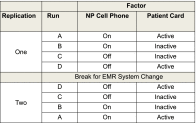Improving notification of sexually transmitted infections: a quality improvement project and planned experiment
- PMID: 22753557
- PMCID: PMC4074614
- DOI: 10.1542/peds.2011-3326
Improving notification of sexually transmitted infections: a quality improvement project and planned experiment
Abstract
Background and objective: Inadequate follow-up of positive sexually transmitted infection (STI) test results is a gap in health care quality that contributes to the epidemic of STIs in adolescent women. The goal of this study was to improve our ability to contact adolescent women with positive STI test results after an emergency department visit.
Methods: We conducted an interventional quality improvement project at a pediatric emergency department. Phase 1 included plan-do-study-act cycles to test interventions such as provider education and system changes. Phase 2 was a planned experiment studying 2 interventions (study cell phone and patient activation card), using a 2 × 2 factorial design with 1 background variable and 2 replications. Outcomes were: (1) the proportion of women aged 14 to 21 years with STI testing whose confidential telephone number was documented in the electronic medical record; (2) the proportion of STI positive women successfully contacted within 7 days.
Results: Phase 1 interventions increased the proportion of records with a confidential number from 24% to 58% and the proportion contacted from 45% to 65%, and decreased loss to follow-up from 40% to 24%. In phase 2, the proportion contacted decreased after the electronic medical record system changed and recording of the confidential number decreased. Study interventions (patient activation card and study cell phone) had a synergistic effect on successful contact, especially when confidential numbers were less reliably documented.
Conclusions: Feasible and sustainable interventions such as improved documentation of a confidential number worked synergistically to increase our ability to successfully contact adolescent women with their STI test results.
Figures







References
-
- Centers for Disease Control and Prevention. Sexually Transmitted Disease Surveillance, 2008. Atlanta, GA: US Department of Health and Human Services; 2009
-
- Huppert JS, Mortensen JE, Reed JL, et al. . Rapid antigen testing compares favorably with transcription-mediated amplification assay for the detection of Trichomonas vaginalis in young women. Clin Infect Dis. 2007;45(2):194–198 - PubMed
-
- Workowski KA, Berman S. Sexually transmitted diseases treatment guidelines, 2010. MMWR Recomm Rep. 2010;59(RR-12):2–8 - PubMed
-
- Yealy DM, Greene TJ, Hobbs GD. Underrecognition of cervical Neisseria gonorrhoeae and Chlamydia trachomatis infections in the emergency department. Acad Emerg Med. 1997;4(10):962–967 - PubMed
Publication types
MeSH terms
Grants and funding
LinkOut - more resources
Full Text Sources
Medical
Miscellaneous

